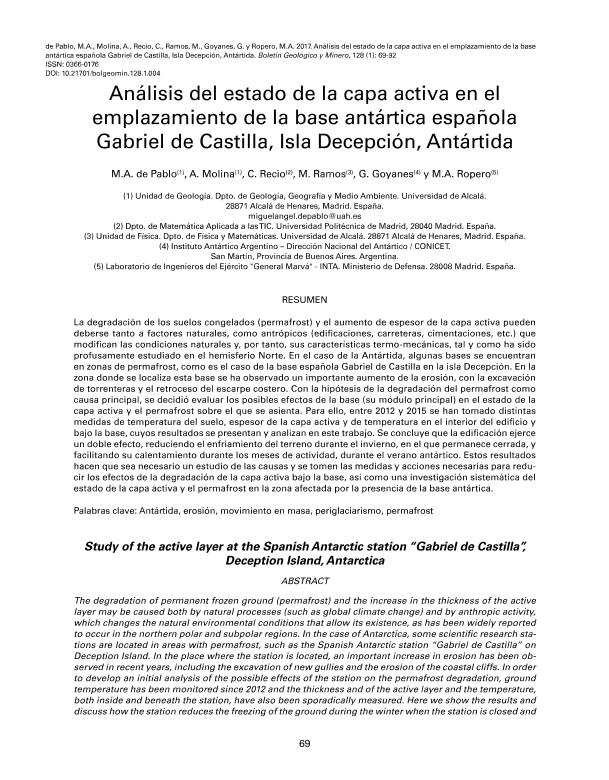Mostrar el registro sencillo del ítem
dc.contributor.author
de Pablo, M. A.
dc.contributor.author
Molina, A.
dc.contributor.author
Recio, C.
dc.contributor.author
Ramos, M.
dc.contributor.author
Goyanes, Gabriel Alejandro

dc.contributor.author
Ropero, M. A.
dc.date.available
2019-04-01T17:08:17Z
dc.date.issued
2017-03
dc.identifier.citation
de Pablo, M. A.; Molina, A.; Recio, C.; Ramos, M.; Goyanes, Gabriel Alejandro; et al.; Análisis del estado de la capa activa en el emplazamiento de la base antártica española Gabriel de Castilla, Isla Decepción, Antártida; Instituto Geológico y Minero de España; Boletín Geológico y Minero; 128; 1; 3-2017; 69-92
dc.identifier.issn
0366-0176
dc.identifier.uri
http://hdl.handle.net/11336/72930
dc.description.abstract
La degradación de los suelos congelados (permafrost) y el aumento de espesor de la capa activa pueden deberse tanto a factores naturales, como antrópicos (edificaciones, carreteras, cimentaciones, etc.) que modifican las condiciones naturales y, por tanto, sus características termo-mecánicas, tal y como ha sido profusamente estudiado en el hemisferio Norte. En el caso de la Antártida, algunas bases se encuentran en zonas de permafrost, como es el caso de la base española Gabriel de Castilla en la isla Decepción. En la zona donde se localiza esta base se ha observado un importante aumento de la erosión, con la excavación de torrenteras y el retroceso del escarpe costero. Con la hipótesis de la degradación del permafrost como causa principal, se decidió evaluar los posibles efectos de la base (su módulo principal) en el estado de la capa activa y el permafrost sobre el que se asienta. Para ello, entre 2012 y 2015 se han tomado distintas medidas de temperatura del suelo, espesor de la capa activa y de temperatura en el interior del edificio y bajo la base, cuyos resultados se presentan y analizan en este trabajo. Se concluye que la edificación ejerce un doble efecto, reduciendo el enfriamiento del terreno durante el invierno, en el que permanece cerrada, y facilitando su calentamiento durante los meses de actividad, durante el verano antártico. Estos resultados hacen que sea necesario un estudio de las causas y se tomen las medidas y acciones necesarias para reducirlos efectos de la degradación de la capa activa bajo la base, así como una investigación sistemática del estado de la capa activa y el permafrost en la zona afectada por la presencia de la base antártica.
dc.description.abstract
The degradation of permanent frozen ground (permafrost) and the increase in the thickness of the active layer may be caused both by natural processes (such as global climate change) and by anthropic activity, which changes the natural environmental conditions that allow its existence, as has been widely reported to occur in the northern polar and subpolar regions. In the case of Antarctica, some scientific research stations are located in areas with permafrost, such as the Spanish Antarctic station "Gabriel de Castilla" on Deception Island. In the place where the station is located, an important increase in erosion has been observed in recent years, including the excavation of new gullies and the erosion of the coastal cliffs. In order to develop an initial analysis of the possible effects of the station on the permafrost degradation, ground temperature has been monitored since 2012 and the thickness and of the active layer and the temperature, both inside and beneath the station, have also been sporadically measured. Here we show the results and discuss how the station reduces the freezing of the ground during the winter when the station is closed and facilitates the warming of the ground during the living periods of the station in the Antarctic summer. Those initial results and conclusions make necessary to continue the study of the permafrost and the active layer in the station site by systematic monitoring of the ground temperature and the thickness of the active layer.
dc.format
application/pdf
dc.language.iso
spa
dc.publisher
Instituto Geológico y Minero de España
dc.rights
info:eu-repo/semantics/openAccess
dc.rights.uri
https://creativecommons.org/licenses/by/2.5/ar/
dc.subject
Antártida
dc.subject
Erosión
dc.subject
Movimiento en Masa
dc.subject
Periglaciarismo
dc.subject
Permafrost
dc.subject.classification
Meteorología y Ciencias Atmosféricas

dc.subject.classification
Ciencias de la Tierra y relacionadas con el Medio Ambiente

dc.subject.classification
CIENCIAS NATURALES Y EXACTAS

dc.title
Análisis del estado de la capa activa en el emplazamiento de la base antártica española Gabriel de Castilla, Isla Decepción, Antártida
dc.title
Study of the active layer at the Spanish Antarctic station “Gabriel de Castilla”, Deception Island, Antarctica
dc.type
info:eu-repo/semantics/article
dc.type
info:ar-repo/semantics/artículo
dc.type
info:eu-repo/semantics/publishedVersion
dc.date.updated
2019-03-29T12:06:39Z
dc.journal.volume
128
dc.journal.number
1
dc.journal.pagination
69-92
dc.journal.pais
España

dc.journal.ciudad
Madrid
dc.description.fil
Fil: de Pablo, M. A.. Universidad de Alcalá; España
dc.description.fil
Fil: Molina, A.. Universidad de Alcalá; España
dc.description.fil
Fil: Recio, C.. Universidad Politécnica de Madrid; España
dc.description.fil
Fil: Ramos, M.. Universidad de Alcalá; España
dc.description.fil
Fil: Goyanes, Gabriel Alejandro. Consejo Nacional de Investigaciones Científicas y Técnicas; Argentina. Ministerio de Relaciones Exteriores, Comercio Interno y Culto. Dirección Nacional del Antártico. Instituto Antártico Argentino; Argentina
dc.description.fil
Fil: Ropero, M. A.. Ministerio de Defensa. Instituto Nacional de Técnica Aeroespacial. Laboratorio de Ingenieros del Ejército "General Marvá"; España
dc.journal.title
Boletín Geológico y Minero

dc.relation.alternativeid
info:eu-repo/semantics/altIdentifier/url/http://www.igme.es/Boletin/2017/128_1.htm
dc.relation.alternativeid
info:eu-repo/semantics/altIdentifier/doi/http://dx.doi.org/10.21701/bolgeomin.128.1.004
dc.relation.alternativeid
info:eu-repo/semantics/altIdentifier/url/https://dialnet.unirioja.es/servlet/articulo?codigo=6026118
Archivos asociados
